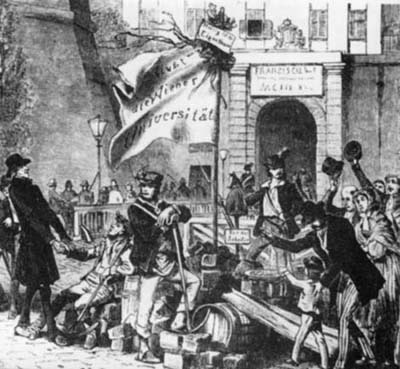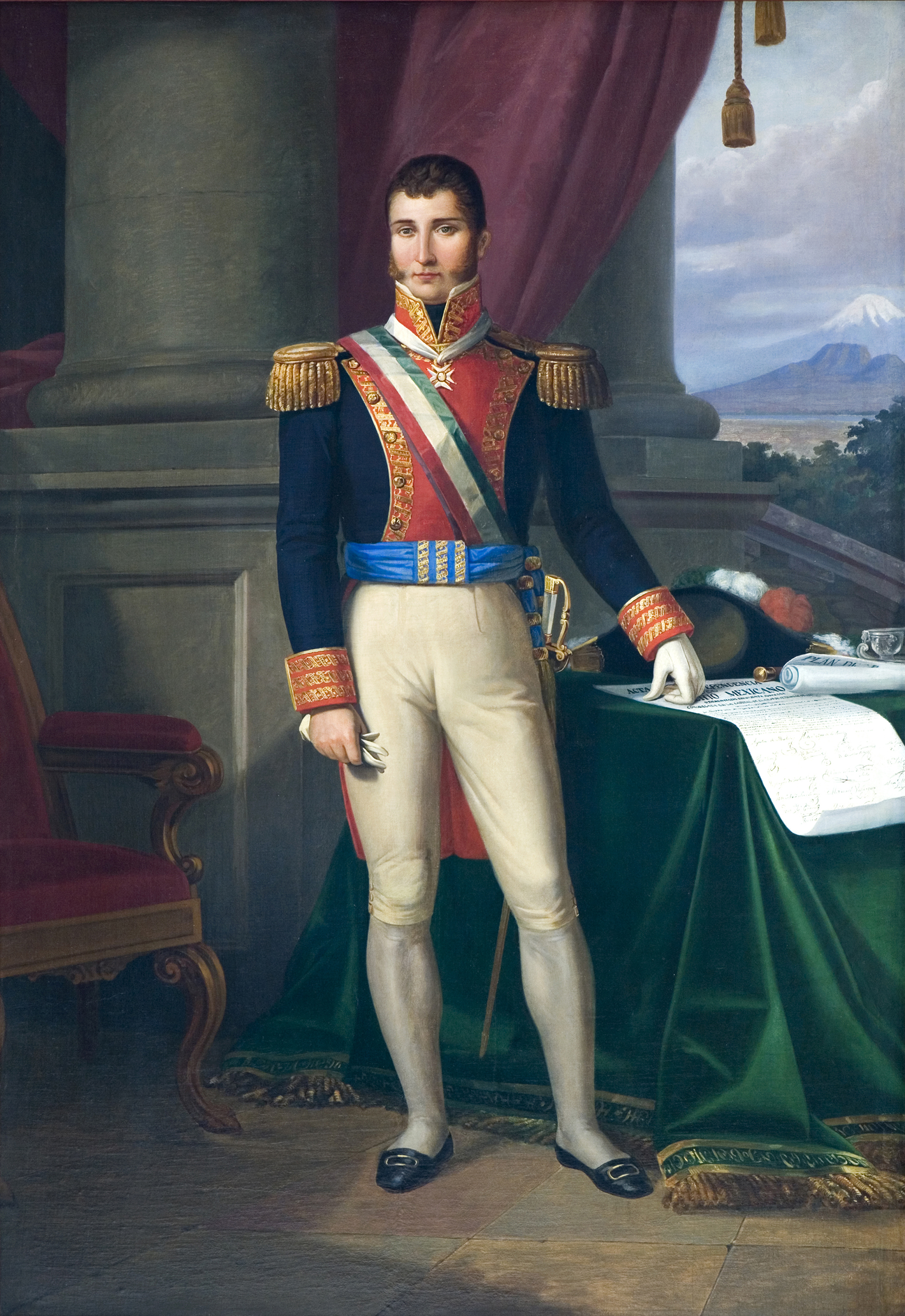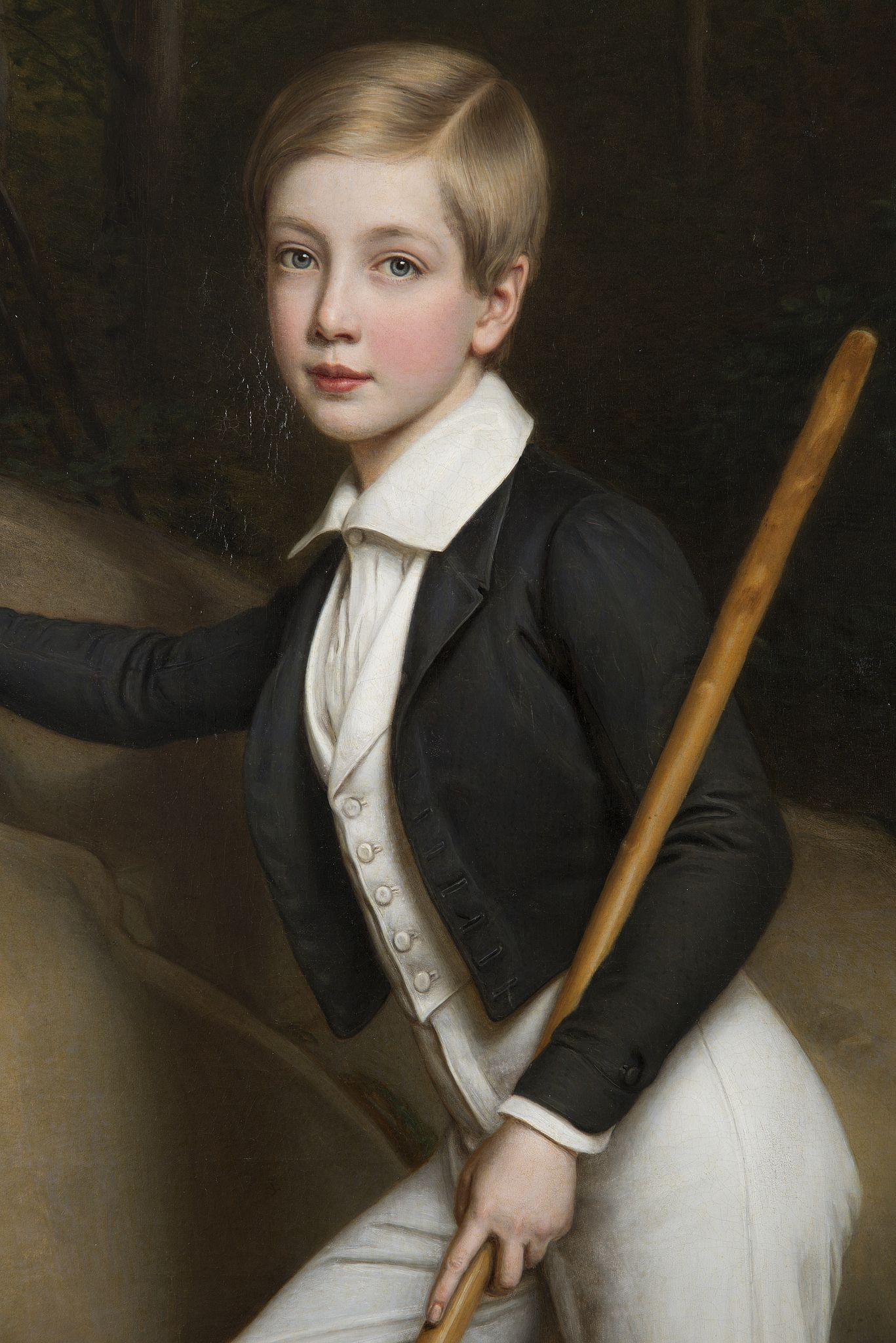|
Sophie, Princess Of Bavaria
Princess Sophie of Bavaria (Sophie Friederike Dorothea Wilhelmine; 27 January 1805 – 28 May 1872) was the daughter of King Maximilian I Joseph of Bavaria and his second wife, Caroline of Baden. The identical twin sister of Queen Maria Anna of Saxony, Sophie became Archduchess of Austria by marriage to Archduke Franz Karl of Austria. Her eldest son, Franz Joseph, reigned as Emperor of Austria and King of Hungary; her second son, Maximilian, briefly reigned as Emperor of Mexico. Childhood (1805–1824) The fourth child of King Maximilian I Joseph of Bavaria and Princess Caroline of Baden, Princess Sophie Friederike Dorothea Wilhelmine was born on 27 January 1805 in Nymphenburg Palace, Munich. She was said to be her father’s favorite daughter although she was more attached to her mother, whom she loved dearly. Sophie adored her twin sister Maria Anna and was very close to all her sisters. Archduchess of Austria (1824–1872) On 4 November 1824, she married Archduke Fran ... [...More Info...] [...Related Items...] OR: [Wikipedia] [Google] [Baidu] |
Joseph Karl Stieler
Joseph Karl Stieler (1 November 1781 – 9 April 1858) was a German painter. From 1820 until 1855 he worked as royal court painter for the King of Bavaria, Bavarian kings. He is known for his Neoclassicism, Neoclassical portraits, especially for the Gallery of Beauties at Nymphenburg Palace in Munich, as well as his Beethoven with the Manuscript of the Missa Solemnis, emblematic portrait of Ludwig van Beethoven, which has become one of his most famous works. Life Born in the city of Mainz to a long-established family of engraving, engravers, punchcutting, punchcutters and Tool and die maker, die makers, Stieler received some artistic training from his father, August Friedrich Stieler (1736–1789). After the early death of his father, Joseph Karl autodidactism, autodidactically completed his apprenticeship and began his career as a painter of Portrait miniature, miniatures, which were increasingly sought after by bourgeoisie, bourgeois circles. After Mainz had been occupied by ... [...More Info...] [...Related Items...] OR: [Wikipedia] [Google] [Baidu] |
Maria Anna Of Bavaria (1805-1877)
Princess Maria Anna of Bavaria (; 27 January 1805 – 13 September 1877), known as 'Marie' was Queen of Saxony from 1836 to 1854 as the second wife of King Frederick Augustus II of Saxony. Biography Maria Anna was born in Munich, the daughter of Maximilian I Joseph of Bavaria and his second wife, Karoline of Baden. She was the identical twin sister of Princess Sophie of Bavaria, mother of Emperor Franz Joseph I of Austria and Emperor Maximilian I of Mexico. She and her sister were their parent's second set of twins. Their younger sister, Ludovika, was mother of Empress Elisabeth of Austria and Queen Maria Sophie of the Two Sicillies. Marriage On 24 April 1833 in Dresden, Maria married Frederick, Crown Prince of Saxony, whose brother Prince John of Saxony was married to her sister Amalie. In 1836, Frederick succeeded his uncle Anthony as king, making her queen. There were no children from the marriage. Her husband, King Frederick Augustus II, died in 1854. In 1836, du ... [...More Info...] [...Related Items...] OR: [Wikipedia] [Google] [Baidu] |
Princess Maria Annunciata Of Bourbon-Two Sicilies
Princess Maria Annunciata Isabella Filomena Sebasia of Bourbon-Two Sicilies (Italian: ''Maria Annunziata Isabella Filomena Sebasia, Principessa di Borbone delle Due Sicilie''; 24 March 1843 – 4 May 1871)Gothaischer genealogischer Hof-Kalender: auf das Jahr 1846. (1846). Germany: (Perthes, Gotha). 75. Accessed from Google Books. was a political figure from the House of Bourbon-Two Sicilies. In 1862, she married Archduke Karl Ludwig of Austria; however, their marriage was short-lived due to her premature death in 1871. She is known for being the mother of Archduke Franz Ferdinand of Austria, whose assassination in Sarajevo precipitated the start of World War I. Early years (1843–1861) Maria Annunciata Isabella Filomena Sabasia, known as Maria Annunciata to the public and “Ciolla” to her family, was born on 24 March 1843 at the Royal Palace of Caserta to King Ferdinand II of the Two Sicilies and his wife, Archduchess Maria Theresa of Austria. She was the fourth of their twel ... [...More Info...] [...Related Items...] OR: [Wikipedia] [Google] [Baidu] |
Empress Elisabeth Of Austria
Elisabeth (born Duchess Elisabeth Amalie Eugenie in Bavaria; 24 December 1837 – 10 September 1898), nicknamed Sisi or Sissi, was Empress of Austria and List of Hungarian consorts, Queen of Hungary from her marriage to Franz Joseph I of Austria on 24 April 1854 until her assassination in 1898. Elisabeth was born into the Bavarian House of Wittelsbach but enjoyed an informal upbringing before marrying her first cousin, Emperor Franz Joseph I, at 16. The marriage thrust her into the much more formal Habsburg court life, for which she was unprepared and which she found suffocating. The couple had four children: Archduchess Sophie of Austria, Sophie, Archduchess Gisela of Austria, Gisela, Rudolf, Crown Prince of Austria, Rudolf, and Archduchess Marie Valerie of Austria, Marie Valerie. Early in her marriage, Elisabeth was at odds with her aunt and mother-in-law, Princess Sophie of Bavaria, Archduchess Sophie, who took over the rearing of Elisabeth's children. The birth of a son, Rud ... [...More Info...] [...Related Items...] OR: [Wikipedia] [Google] [Baidu] |
Franz Joseph
Franz Joseph I or Francis Joseph I ( ; ; 18 August 1830 – 21 November 1916) was Emperor of Austria, King of Hungary, and the ruler of the Grand title of the emperor of Austria, other states of the Habsburg monarchy from 1848 until his death in 1916. In the early part of his reign, his realms and territories were referred to as the Austrian Empire, but were reconstituted as the dual monarchy of Austria-Hungary in 1867. From 1 May 1850 to 24 August 1866, he was also president of the German Confederation. In December 1848, Franz Joseph's uncle Emperor Ferdinand I of Austria, Ferdinand I abdicated the throne at Olomouc, as part of Minister President Felix zu Schwarzenberg's plan to end the Hungarian Revolution of 1848. Franz Joseph then acceded to the throne. In 1854, he married his first cousin Empress Elisabeth of Austria, Duchess Elisabeth in Bavaria, with whom he had four children: Archduchess Sophie of Austria, Sophie, Archduchess Gisela of Austria, Gisela, Rudolf, Crown Pri ... [...More Info...] [...Related Items...] OR: [Wikipedia] [Google] [Baidu] |
Revolutions Of 1848 In The Habsburg Areas
The revolutions of 1848 in the Austrian Empire took place from March 1848 to November 1849. Much of the revolutionary activity had a nationalist character: the Austrian Empire, ruled from Vienna, included ethnic Germans, Hungarians, Poles, Bohemians (Czechs), Ruthenians (Ukrainians), Slovenes, Slovaks, Romanians, Croats, Italians, and Serbs; all of whom attempted in the course of the revolution to either achieve autonomy, independence, or even hegemony over other nationalities. The nationalist picture was further complicated by the simultaneous events in the German states, which moved toward greater German national unity. Besides these nationalists, liberal and socialist currents resisted the Empire's longstanding conservatism. Background The events of 1848 were the product of mounting social and political tensions after the Congress of Vienna of 1815. During the "pre-March" period, the already conservative Austrian Empire moved further away from ideas of the Age of Enlight ... [...More Info...] [...Related Items...] OR: [Wikipedia] [Google] [Baidu] |
Francis II, Holy Roman Emperor
Francis II and I (; 12 February 1768 – 2 March 1835) was the last Holy Roman Emperor as Francis II from 1792 to 1806, and the first Emperor of Austria as Francis I from 1804 to 1835. He was also King of Hungary, List of rulers of Croatia, Croatia and List of Bohemian monarchs, Bohemia, and served as the first president of the German Confederation following its establishment in 1815. The eldest son of future Leopold II, Holy Roman Emperor, Emperor Leopold II and Maria Luisa of Spain, Francis was born in Florence, where his father ruled as List of grand dukes of Tuscany, Grand Duke of Tuscany. Leopold became Holy Roman Emperor in 1790 but died two years later, and Francis succeeded him. His empire immediately became embroiled in the French Revolutionary Wars, the first of which ended in Austrian defeat and the loss of the left bank of the Rhine to France. After another French victory in the War of the Second Coalition, Napoleon crowned himself Emperor of the French. In response, ... [...More Info...] [...Related Items...] OR: [Wikipedia] [Google] [Baidu] |
Caroline Augusta Of Bavaria
Princess Caroline Augusta of Bavaria (; 8 February 1792 – 9 February 1873) was List of Austrian royal consorts, Empress of Austria by marriage to Francis II, Holy Roman Emperor, Francis I of Austria. She was the penultimate child and third daughter of King Maximilian I Joseph of Bavaria and Princess Augusta Wilhelmine of Hesse-Darmstadt. She firstly married to Crown Prince William I of Württemberg, William of Württemberg in 1808, but they lived separately in 1814. Early life Caroline Augusta was born on 8 February 1792 in Mannheim, Electoral Palatinate. She was the fourth child and third daughter of Maximilian I Joseph of Bavaria and his wife, Princess Augusta Wilhelmine of Hesse-Darmstadt. At the age of two, Caroline Augusta caught smallpox. First marriage On 8 June 1808, in Munich, Caroline Augusta married Crown Prince William I of Württemberg, William of Württemberg (1781–1864), becoming crown princess of Württemberg. They had no children and were living separately ... [...More Info...] [...Related Items...] OR: [Wikipedia] [Google] [Baidu] |
Joseph Karl Stieler - Portrait Of The Youngest Daughters Of Maximilian I Of Bavaria (Sophie, Marie, And Ludovika)
Joseph is a common male name, derived from the Hebrew (). "Joseph" is used, along with " Josef", mostly in English, French and partially German languages. This spelling is also found as a variant in the languages of the modern-day Nordic countries. In Portuguese and Spanish, the name is "José". In Arabic, including in the Quran, the name is spelled , . In Kurdish (''Kurdî''), the name is , Persian, the name is , and in Turkish it is . In Pashto the name is spelled ''Esaf'' (ايسپ) and in Malayalam it is spelled ''Ousep'' (ഔസേപ്പ്). In Tamil, it is spelled as ''Yosepu'' (யோசேப்பு). The name has enjoyed significant popularity in its many forms in numerous countries, and ''Joseph'' was one of the two names, along with ''Robert'', to have remained in the top 10 boys' names list in the US from 1925 to 1972. It is especially common in contemporary Israel, as either "Yossi" or "Yossef", and in Italy, where the name "Giuseppe" was the most common ma ... [...More Info...] [...Related Items...] OR: [Wikipedia] [Google] [Baidu] |
Emperor Of Mexico
The Emperor of Mexico () was the head of state and head of government of Mexico on two non-consecutive occasions during the 19th century. With the Mexican Declaration of Independence from Spain in 1821, Mexico briefly became an independent monarchy – the First Mexican Empire The Mexican Empire (, ) was a constitutional monarchy and the first independent government of Mexico. It was also the only former viceroyalty of the Spanish Empire to establish a monarchy after gaining independence. The empire existed from 18 .... For a few years in the mid-1860s, Mexico reverted to being a monarchy – the Second Mexican Empire. In both instances, the reigning emperor was forcibly deposed and then executed. First Mexican Empire (1821–1823) Decree The Sovereign Mexican Constituent Congress decreed on June 22, 1822 the following: Second Mexican Empire (1863–1867) Decree The Superior Government Junta by the Conservative Party decreed on July 11, 1863 the follo ... [...More Info...] [...Related Items...] OR: [Wikipedia] [Google] [Baidu] |
Maximilian I Of Mexico
Maximilian I (; ; 6 July 1832 – 19 June 1867) was an Austrian Empire, Austrian archduke who became Emperor of Mexico, emperor of the Second Mexican Empire from 10 April 1864 until his execution by the Restored Republic (Mexico), Mexican Republic on 19 June 1867. A member of the House of Habsburg-Lorraine, Maximilian was the younger brother of Emperor Franz Joseph I of Austria. Before becoming Emperor of Mexico, he was commander-in-chief of the small Imperial Austrian Navy and briefly the Austrian viceroy of Kingdom of Lombardy–Venetia, Lombardy–Venetia, but was removed by the emperor. Two years before his dismissal, he briefly met with French emperor Napoleon III in Paris, where he was approached by Conservative Party (Mexico), conservative Monarchism in Mexico, Mexican monarchists seeking a European royal to rule Mexico. Initially Maximilian was not interested, but following his dismissal as viceroy, the Mexican monarchists' plan was far more appealing to him. Since Maxim ... [...More Info...] [...Related Items...] OR: [Wikipedia] [Google] [Baidu] |









